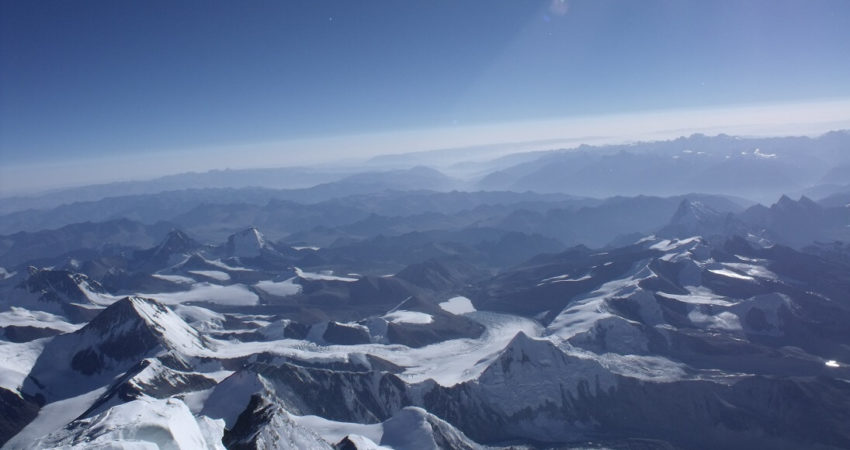I get asked this question all the time and it is a really difficult question to answer without using the phrase “it depends’, but I’ll see what I can do.
I’ll start with the weather at the top of Everest and then talk about the weather at basecamp. The top of Everest is easier to describe, because most of the year it is similar. It is very windy and very cold.
“… blasted by winds over 100mph …”
For most of the year the summit of Everest is blasted by winds over 100mph (160kmh). This is because it is so tall (just under 30,000 feet (9000m)) that it sticks up into the jet stream, or the area of the atmosphere that the high winds continuously blow. A lot of photos of Everest show a sideways cloud coming from the summit. This is sometimes called the plume of Everest and it is snow, cloud and ice crystals blasting off the summit, caused by the high winds. When you see the plume on Everest, no one can go to the summit.
At some point in the spring, usually around early to mid May, the monsoon weather in the Indian Ocean pushes north over the sub-continent and this in turn pushes the high winds away to the north of Everest. This is the “weather window” that climbers use to find calmer weather at the summit. There is a similar situation caused by the impending arrival of winter that occurs in late October/early November, but this “window” is more unstable, darker and colder, so very few expeditions try to climb Everest in the post-monsoon (autumn) season.
The top of Everest is also very cold. If you’ve ever flown in a plane that has a display of things like altitude, speed and time to destination; look carefully because it will also display the outside temperature. Any time you pass through 29,000 feet (8900m) check the temperature. It will probably be in the range of -35 to -55 degrees (either f or c, doesn’t matter – they meet at -40). Those are some cold air temperatures. Add in wind chill at 100mph and we’re probably talking “feels-like” temps around -80. Of course there are some warmer days and actually Everest is often a bit warmer that your plane’s thermometer because of the air that blows up it’s side from the warm valleys below. Still, if the temperature is around -10c (16f) on the summit for climbers, that would be a nice, warm summit day! When I was on top, there was a light breeze, lots of sun and the temperature was -25c (-13f) and it felt nice!
“spring is beautiful and sunny”
Everest basecamp is very different. There are four seasons in the Khumbu, although summer is sometimes referred to as the monsoon. They are what you’d expect for the most part. Winter is very cold and it snows often. Spring is beautiful and sunny, but almost every afternoon it clouds up and sometimes a dusting of snow falls. Summer (monsoon) is warm and wet. At Everest basecamp (EBC) there are many storms and they can drop huge amounts of snow. In the autumn, the monsoon storms end and sunny warm days like spring appear until the crispy coldness creeps back into the air, the days shorten and winter rolls in again.
Temperatures at EBC vary greatly, even during one day. The sun plays a huge role in this. In May the day may dawn at EBC at -10c (16f), but when the sun hits you, the air warms up rapidly to +10c (50f). Many spring days the air temperature is around 20c (66f) for much of the day, but as soon as the sun slides behind a cloud, or drops beyond a ridge, the temperature begins to plummet back down to iciness. The same kind of temperatures can be found at EBC during the autumn, but here the days are growing shorter and the “heating” time is less each day.
Ever wonder how much it costs to climb Everest, we have the details here.
